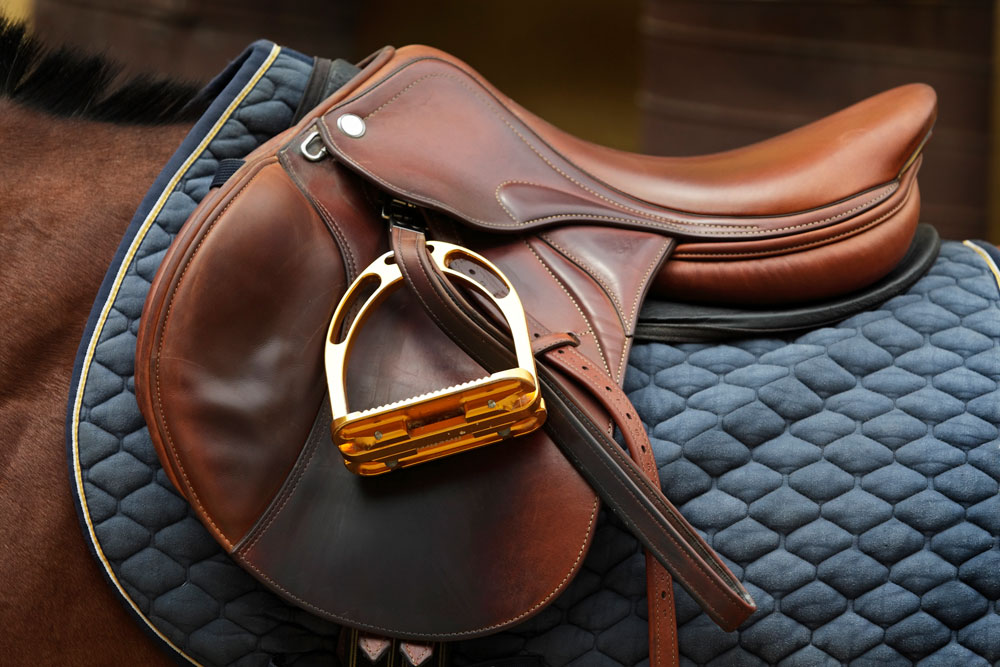
A discussion on saddle fit at the 2020 American Association of Equine Practitioners Convention offered many key points of use to horse owners.
Erin Contino, DVM, MS, MCVSMR, Assistant Professor at Colorado State University’s College of Veterinary and Biomedical Sciences, said before placing the saddle on a horse, you should evaluate of the flocking to look for signs of consistency or consolidation. She also recommended checking to see if the rails of the saddle tree bulge past the panels, and to check the saddle symmetry.
Once the horse is saddled, look to see that the lowest point is equivalent to the lowest point on the horse’s back, which is usually located around thoracic vertebrae-13. Check that the seat is level—the pommel and cantle should be balanced. Run a hand beneath the tree points to check for focal pressure and do the same for the panels on each side. The saddle should fit the shape of the horse’s back and have consistent contact without bridging. Then, check visible saddle clearance along the spine from the back.
Without a rider, you should be able to place four fingers at the gullet over the withers and have good clearance the full length of the gullet. Ideally, the tree shouldn’t exceed the 18th rib in length. If it extends to the first lumbar vertebrae, Sue Dyson, MA, VetMB, PhD, from Britain, says this isn’t necessarily a problem provided the gusset at the back of the saddle doesn’t extend more rearward.
Do the same testing once the saddle is girthed up. There should still be a couple fingers width clearance under the gullet. Another important point is to be sure the saddle pad doesn’t bunch up in the gullet area.
It’s important to see where a rider places the saddle, said Dyson. She noted that the saddle is often placed too far forward, which is likely to restrict rotation of the scapula. The saddle flap is flexible so the scapula can slide beneath it. The tree points must be at least a hands breadth behind the back of the scapula when the horse is in the weight-bearing position.
Check to see how the billets hang—they should be perpendicular to the ground. She suggested also checking where the girth lies. A barrel-chested horse might cause the girth to move close enough to the elbow to pull the saddle forward as well as tipping up the rear of the saddle.
Another important point is to fit the saddle to the rider as well as the horse. For effective, balanced riding, the rider should sit in the middle of the saddle as close to the center of gravity as possible. If a saddle is too short for a rider, then the rider ends up sitting on the cantle. A rider with long legs might find the bars of the saddle, and hence the stirrup leathers, in the wrong place. An inappropriate fit of a saddle often places the rider in a chair-sitting position. Any of these improper fits potentially compromises rider position enough to upset the synchrony of horse and rider.
Even though a saddle might be fit to a horse by a saddle-fitting professional, there are variabilities as to what is considered an appropriate size of tree. This should be taken into account if problems still arise following a fitting.
For a young, growing horse or a horse in training, the horse’s back needs to move during exercise in order to achieve normal epaxial muscle development. Any impingement of the saddle on a horse’s movement is a problem. If an ill-fitting saddle is replaced with a good-fitting one, there is demonstrably obvious improvement of the epaxial muscles within two months as the now-unrestricted muscles are able to develop.
Check the saddle fit at least every three months in young horses and those in training, urged Dyson. Muscles develop and change the way the saddle fits.
Contino pointed out that if shoulder muscles appear asymmetric, then it is more likely to be a musculoskeletal issue that should be evaluated first, then look at saddle fit.
Dyson stressed that appropriate saddle fit doesn’t mean that you’ll be able to use your favorite saddle on every horse you ride. In some cases, this won’t optimize the horse’s performance because of individual variations of each horse’s back that preclude a perfect fit of one saddle on every horse.



